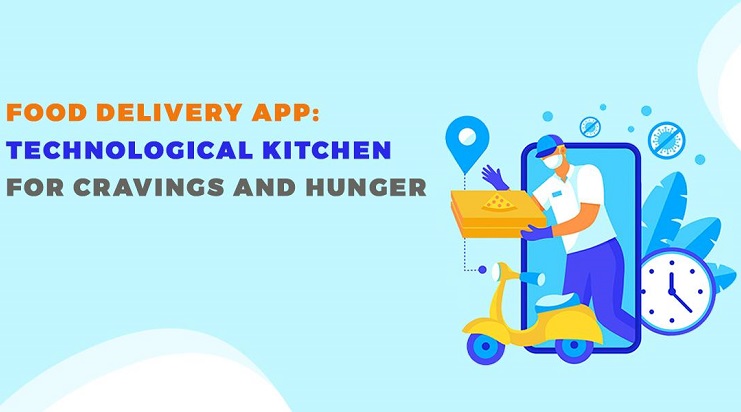
How to Develop an On-Demand Food Delivery App
The ongoing pandemic boosted the demand for such on-demand services as the companies in this sector developed a monopolistic approach to surviving under such lockdown by stating that the food items of their company is untouched and is prepared with due precautions of Covid-19.
Some branded companies have even developed different kinds of stickers such as untouched, secured and much more. Though they may or may not be untouched but such things can gain the trust of customers very easily.
With such things and the favourable environment for on-demand services, this sector entered its peak point by generating a revenue of about $122,739 million.
There are basically 2 kinds of structures which prevail in this sector of on-demand food services: Platform to customer delivery and restaurant to customer delivery.
Platform to customer delivery is nothing but the app a customer uses other than the actual restaurant app such as Uber Eats. Such an app acts as a mediator between the restaurant and the customer.
Restaurant to customer delivery app refers to an app where a customer uses the actual app of a restaurant to get its delivery. Dominoes, McDonald’s and KFC are some of the examples.
Among the top 10 list of downloads, KFC and Dominos are the only apps from the second category.
In this article, we will discuss the things you need to know before developing a platform for customer delivery apps.
Major challenge
The greatest challenge faced by the developers of on-demand delivery app development is the targeted audience because such apps are being used by the customers, Delivery men and restaurants.
There is a synchronization channel of all such users on the same app. So what kind of audience we are targeting becomes a major question which needs to be addressed before starting the process of app development.
Features:
1. Search and Menu
Collecting data from different restaurants and cafes is one of the main features of such a platform.
The user must be provided with accurate information about restaurants- Addresses, timings, Menu, Cost and everything attached with it. This enhances the knowledge of the customer as well as motivates him/her to use the app more often.
For business owners, there are various authenticated results just like Grubhub application program interface(API).
2. Third party APIs
Such APIs can be taken into consideration to procure data on menu and restaurants and the data is in thousands.
Such APIs can get updates from restaurants and cafe owners with regards to its menu and cost of the food items.
App owners can also make proper utilisation of such APIs to transfer order information in conjunction with payment details for the partner restaurants.
Whenever an app owner wants to approach such APIs they just have to write directly to the Grubhub team.
There are several other APIs of different companies such as Zomato, postmates and more.
3. Entering into Partnerships
Every restaurant is not enjoying the service which they are supposed to receive from such apps as recently there were complaints from the users about food deliveries being late and many more.
Because of such negative feedback restaurants don’t want the names of their restaurants to be on the list.
To get rid of such situations, direct partnerships with restaurants can bring the favourable outcome. Such direct connections cut down all the negative feedback.
4. Estimated delivery time
When the delivery time gets mentioned in an app or in other words when a customer knows the estimated time of arrival, hunger gets triggered but frustration gets down.
Some of the food delivery platforms are also providing such facilities such as Zomato, Postmates and more.
How accurately the delivery time is predicted is the new talk of this industry. This all gets possible because of Machine learning. The algorithms in machine learning make it possible to take into consideration factors such as arrival time, availability of delivery boys and location of the restaurants.
5. Payments
Apps being built nowadays come with integrated payment methods. Dominoes and Pizza Hut are examples of such apps.
An app owner must try to include multiple payment methods. This way, customers would be able to pay via the method they are most comfortable with.
Technologies used:
1. GPS tracking
Uber was the first company to start including GPS in the on-demand food delivery industry after which several companies such as Deliveroo, Postmates and others started using such technology in their apps.
How to include GPS in your app becomes a major question. First of all an app owner must clinch the user’s location.
After clinching the user’s location, the directions and shortest paths are provided to the users which is equally important for both the users as well as drivers.
The final intrinsic is to include software of maps into the apps for customers. Google maps can be included in the Android as well as IOS platforms.
The geolocation libraries of Google and Apple are not the one-shot solution of GPS tracking. In spite of this, an app developer can also use Tomtom’s NavApp or any other library which can be used both on web and mobile.
Instead of Google Maps, Mapbox can be used, and it is also cheaper than Google maps.
2. Chat with couriers and help centres
What if order is not received on time or when the GPS location fails to show the exact location of the customers ? What could be done in such cases?
Direct communication on the apps helps in bringing out feasible solutions to such questions.
Such communication on the particular apps itself and the time for searching out the contact details gets eliminated which helps in gaining more trust of the customers.
Including FAQs and solving the questions of customers on websites and apps makes it more user-friendly and this helps in engaging the customers.
3. Ratings, Reviews and tips
Some companies like Uber Eats, Doordash and other food delivery service providers often deal with freelance drivers and their main task is to make sure that deliveries are made on time.
Rating drivers is not something that we are not aware of. This method allows the companies to review the list of drivers which are based on the ratings and the companies can differentiate between the best and worst drivers.
Tips are among the things which are optional. Based on the service of drivers the customers are asked with an option if they want to provide a tip to the driver or not.
4. Contactless Delivery
Contactless Delivery in the current scenario is the pivotal feature that a customer takes into consideration.
This approach can be easily validated on the app itself as the developers just need to add a checkbox where the user needs to choose to get the delivery which is untouched.
The deliveries and parcels are kept on the floor of the door of the delivery’s location which majorly helps in maintaining social distancing which is an important aspect to curb the possibility of getting infected.
5. Subscriptions
Subscriptions can help the customers to enjoy free delivery services regardless of the amount they need to pay for a particular order.
To subscribe and get a membership the users are needed to pay a nominal charge.
6. Lock-screen widgets
Apps also hold the ability to gratify the customers with some widgets for lock screen on IOS platform which pops up to provide information to customers.
Some apps are already using such widgets but yes there are modifications and innovations available to create something new and unique.
Conclusion
The growth and development of this industry will never stop as it is changing constantly.
Earlier, phone calls and sometimes take away were the methods to eat the restaurant food at home. But then we observed a drastic shift to online ordering.
We recently observed the deliveries of items with the help of drones. Soon drones will replace drivers at a commercial level.
New technologies are being developed which perfectly matches the pace of on-demand food services which accelerates the growth of this industry.
You read a lot. We like that
Want to take your online business to the next level? Get the tips and insights that matter.

